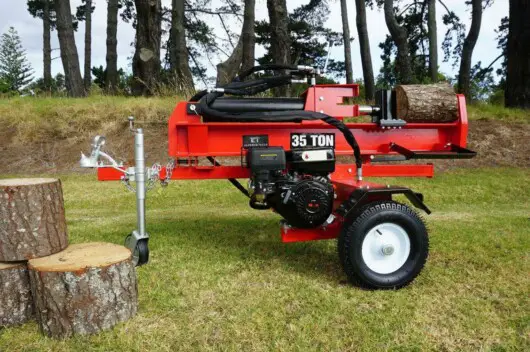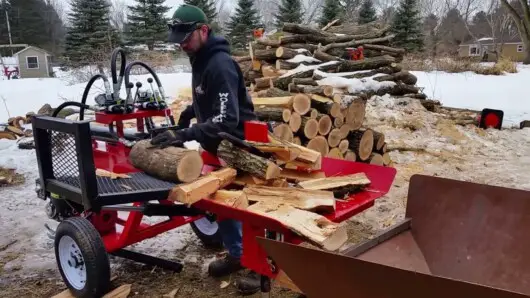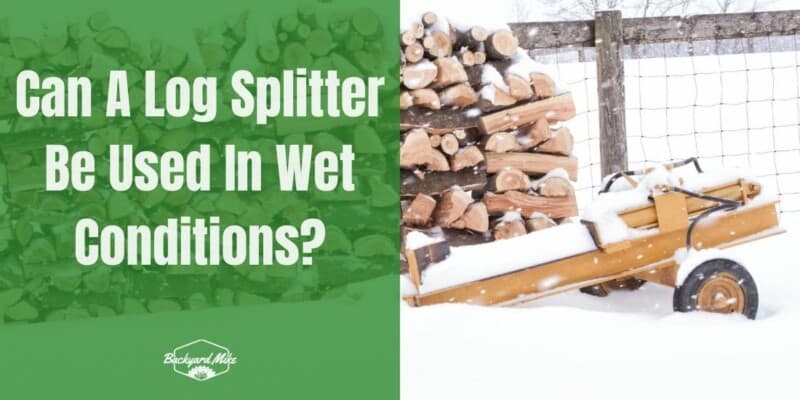Do you own a log splitter, but you’re unsure if it can be used in wet conditions or during rainy days? If so, then you’re in the right place.
Can a log splitter get wet is a common question to have? And the answer to it is yes. This tool is built to tolerate exposure to wet conditions and still work to its optimum best. However, using a log splitter is a dangerous task if you’re not careful. Follow the necessary safety protocols to carry out a safe log splitting session.
In this article, you’ll get to know all about log splitters, can a log splitter get wet, can log splitters be used in the rain, how to keep yourself safe when using a log splitter in wet conditions, and more. Stick around to get all the answers that you’re looking for.
Can a log splitter get wet?
A log cutter or a log splitter is used for splitting different segments of timber logs lengthwise into manageable sizes. Most often they’re split for uses as firewood. Most log splitters are designed as outdoor machinery, and they’re generally intended for rugged, all-weather usage. Generally, log splitters are manufactured to tolerate exposure to wet conditions, including rain and wet conditions. This essentially means that the answer to can a log splitter get wet is yes, they can get wet.
Log splitting is chiefly, largely, an outdoor activity. It’s more convenient to process large amounts of wood in locations where trees are felled or where fire logs can be stored. Nonetheless, it isn’t advisable to disregard some potential short-term and long-term effects of excess water on a log splitter’s operation when using it outdoors.
The type of log splitter you’re using, the availability of storage, the work environment, and the effort you’ve put into maintenance factor into the impact the introduction of water can have on the equipment. There are different types of log splitters that react differently when used in wet conditions.
Electric and indoor log splitters
The most important consideration when a log splitter is exposed to wet conditions is whether it’s made for indoor/outdoor usage. Although people typically think of log splitters as heavy, gas-powered outdoor machinery, there are models specifically designed for indoor use. Indoor log splitters are usually powered by electric motors, and they run on AC power through cables.
An electric log splitter cannot only be damaged when exposed to water, but also poses an electrocution threat to the user. However, certain electric log splitters are created for outdoor use as well. These might or might not be tolerant of long exposure to heavy rain and shouldn’t be stored uncovered outside.
Equipment manuals for log splitters have a list of safety procedures and operation guidelines to make things clear about the intended work environment. It’s important to consult the safety and usage conditions, especially for electric variants, before using the log splitter outdoors.
Gasoline and outdoor log splitters
The most common types of log splitter come powered by gasoline motors. Gas log splitters are pretty heavy, around 500 lbs. or more. They’re typically mounted to wheeled trolleys so that they can be easily transported with a vehicle or a trailer hitch.
Like other gas-powered machinery, like chainsaws, lawnmowers, hedge trimmers, and earth-movers gas log splitters shouldn’t be operated indoors. It’s the case unless they’re being used in specialized buildings with approved ventilation. It can expose the user to toxic fumes from the log splitter’s combustible engine exhaust.
Can you use log splitters in the rain?
Log splitters are a great invention that brings ease to hardwood cutting. As everyone can appreciate, technology has made wood-cutting tools even more powerful than ever before. This makes them capable of dealing with anything and everything, from firewood to oak logs. It can handle things that other equipment like ax and handsaw struggle to take on.
Relatively, log splitters are rather safe to use even in rainy weather. These are often made using stainless steel, rubber cords, plastic, or alloy steel. All these materials will come with their own set of rules when it comes to damage or injury when used in the rain. Interestingly, the rain will have much more effect on the wood than the log splitter. Rain can make the wood wet, which makes it tougher to split compared to dry wood. Moreover, wet wood can be extremely slippery, so you’ll need to be extra careful. The rain can also impair your vision, which can result in potential accidents if not addressed properly.

A lot of logging work gets performed in the forested areas of regions that aren’t known for frequent rain. Not much work can be done if log-splitting activities had to be halted each time there was a slight drizzle. A little awareness and common sense can go a long way in ensuring that the rain doesn’t have any adverse effect on the function of the log splitter.
First, you’ll need to ensure that you’re actually using a log splitter model intended for outdoor use. Most log splitters and almost every gas log splitter fit into this category. However, it won’t hurt to check the owner’s manual for any prohibitions against water on rain. Even if an electric log splitter has been rated for outdoor use, it might not be wise to use it in rain or wet conditions for long.
If it starts raining, ensure that any fluid chamber covers on the log splitter have been tightly closed. This will include the gas cap or any other lids like a hydraulic fluid reservoir or a lubrication oil reservoir. If too much water accidentally gets mixed in the fluid tanks, it can affect the log splitter’s performance. Moreover, it could even cause it to stop running until the gas and other fluids have been replaced. Another thing to remember is that rain-soaked logs could be slower to cut down than dry ones. This will depend on the type of wood and the strength of your log splitter. Working in rainy conditions can therefore take much longer for the given job.
Are log splitters dangerous to use?
Log splitters offer a fairly convenient alternative to manually chopping wood. Instead of chopping wood using an ax, you can directly run it through the log splitter. It’ll automatically cut and split whole wood logs. Maybe you’re simply looking to clear out a wooden property, or you’re stocking up on firewood for the winter. Regardless, there isn’t an easier way of cutting and splitting whole wooden logs than by using log splitters.
So, are log splitters dangerous to use? These tools are designed to be placed in the forest for splitting large logs into smaller flat pieces. They’re pretty easy to use, and the entire process can be executed without much risk. However, there are some precautions that should be taken when using a log splitter. Always practice safe working standards when using a log splitter. Ensure that there aren’t any trees or power lines within reach when you’re working on a log.
Remember, even a slight chance of recklessness when operating log splitters could cause you to lose an arm or worse. You should be alert when using a log splitter, be cautious, and don’t play with a dangerous tool like this. Remember that using a log splitter will be relatively simple. You’ll only need to place the piece of log in the designated place and let the machine do the work. If something happens, it’ll ultimately be your fault and not the log splitter.
Safety measures to consider when using a log splitter in the rain
Equipment failure shouldn’t be your only concern when using a log splitter in rain or wet conditions. The safety of the user must be carefully considered as well. Log splitters are compelling machines that have sharp blades and heavy moving parts. Anyone using a log splitter must be familiar with the proper usage and safety procedures.
Using AC-powered electric log splitters outdoors should only be done according to the instructions mentioned in the user manual. This could prohibit use in heavy rain or in wet conditions due to user safety. When using a gas log splitter in the rain, there are certain safety factors to consider.
You should be aware of the conditions of the work area during wet conditions. The wet or muddy ground can get quite slippery for both people and heavy equipment. As many log splitters come on trailers with wheels, they must be secured so that they don’t move during wheels. They need to be secured such that they don’t move during operation. It can be done using wheel clocks or by directly securing the log splitter to a hitch.

Keeping your footing is also essential when loading the log splitter. Slipping in wet conditions will be extremely dangerous. Always wear proper outdoor footwear and try avoiding muddy work areas, both during and after rainfall. Remember, there are certain weather conditions for which it’ll never be considered safe to work outdoors. Thunderstorms that can potentially bring lightning strikes should be avoided irrespective of what equipment you’re using.
With that said, there are some essential safety tips that you should follow when using a log splitter in rain.
#1. Avoid loose-fitted clothing during wet conditions
Avoid wearing loose-fitted clothing when you’re using a log splitter in rain or wet conditions. Instead, you should choose clothes that fit snug against the body. The problem with loose-fitted clothing is that they could get caught in the log splitter. Log splitters have teeth that grab onto the wood logs. If a piece of clothing accidentally gets caught in the teeth, it could pull your entire body towards the blade. This can end up resulting in hand injuries or something worse.
#2. Lock the wheels when working in the rain
Assuming that your log splitter has wheels (which most of them do these days), remember to lock them in place. Wheels are located at the bottom of log splitters for the purpose of mobility. With wheels, you’ll be able to roll the log splitter into different areas. This will eliminate the need to haul the entire wood logs from the wooded area to your log splitter. Before using the log splitter, you should remember to lock the wheels. Unless the wheels are locked, your log splitter might roll during use.
#3. Keep it well-oiled before use
You’ll have to keep the log splitter well oiled. Most electric log splitters tend to rely on hydraulic oil. Hydraulic oil lubricates its internal parts for ensuring that the log splitter is operating smoothly and as intended. Over time, leaks could occur, which results in the loss of hydraulic oil. Avoid using the log splitter in the rain if it’s low on hydraulic oil. Before working, you should top it off with the right amount so that it can smoothly operate.
#4. Place it on level ground
Another safety tip that you should follow when using a log splitter would be to place it on level ground. Log splitters are generally designed for outdoor use, whether it’s in the sunlight or under the rain. Regardless of whether it’s raining or sunny, place the log splitter on level ground. Log splitters could fall over when they’re used on sloped or angled grounds. These machines vibrate as they’re cutting and splitting the wooden logs. This could result in them falling over and injuring you. Place the log splitter on level ground, as it’ll stabilize them so that they don’t fall over.
#5. Split one log at a time
You shouldn’t attempt to split multiple wooden logs at once. Log splitters aren’t actually designed to split multiple logs simultaneously. Whether you’ve got an electric or a gas log splitter, you must only use it to split one log at a time.
Log splitter storage after using in the rain
Once you’ve used the log splitter, it’s advisable to store it and keep it covered or shielded from external elements. Limiting its exposure to rain or water will prevent or slow down the corrosion of its metal components. Moreover, it’ll also reduce the chances of water seeping into parts of the machinery where it could create issues.
It’s recommended that you should store the log splitter in a garage or shed once you’ve used to log splitter. But before that, remember to clean it and dry it properly. Storing it properly will prolong its lifespan while also preventing future problems. If you need to store out outdoors, tarps and covers are available and can fit most models. Some log splitters might come with a fitted tarp, but they can be purchased separately too.
Conclusion
Thank you for reading. Hopefully, now you know a lot more about log splitters, can a log splitter get wet, can log splitters be used in the rain, how to keep yourself safe when using a log splitter in wet conditions, and more. Anyone who uses log splitters probably has this question if they can be used in rain or wet conditions. The answer to that question is yes. Log splitters are made to tolerate exposure to wet conditions and still work to their optimum best. However, using a log splitter is a dangerous task if you’re not careful. Remember to follow the necessary safety protocols to carry out a safe log splitting session.


